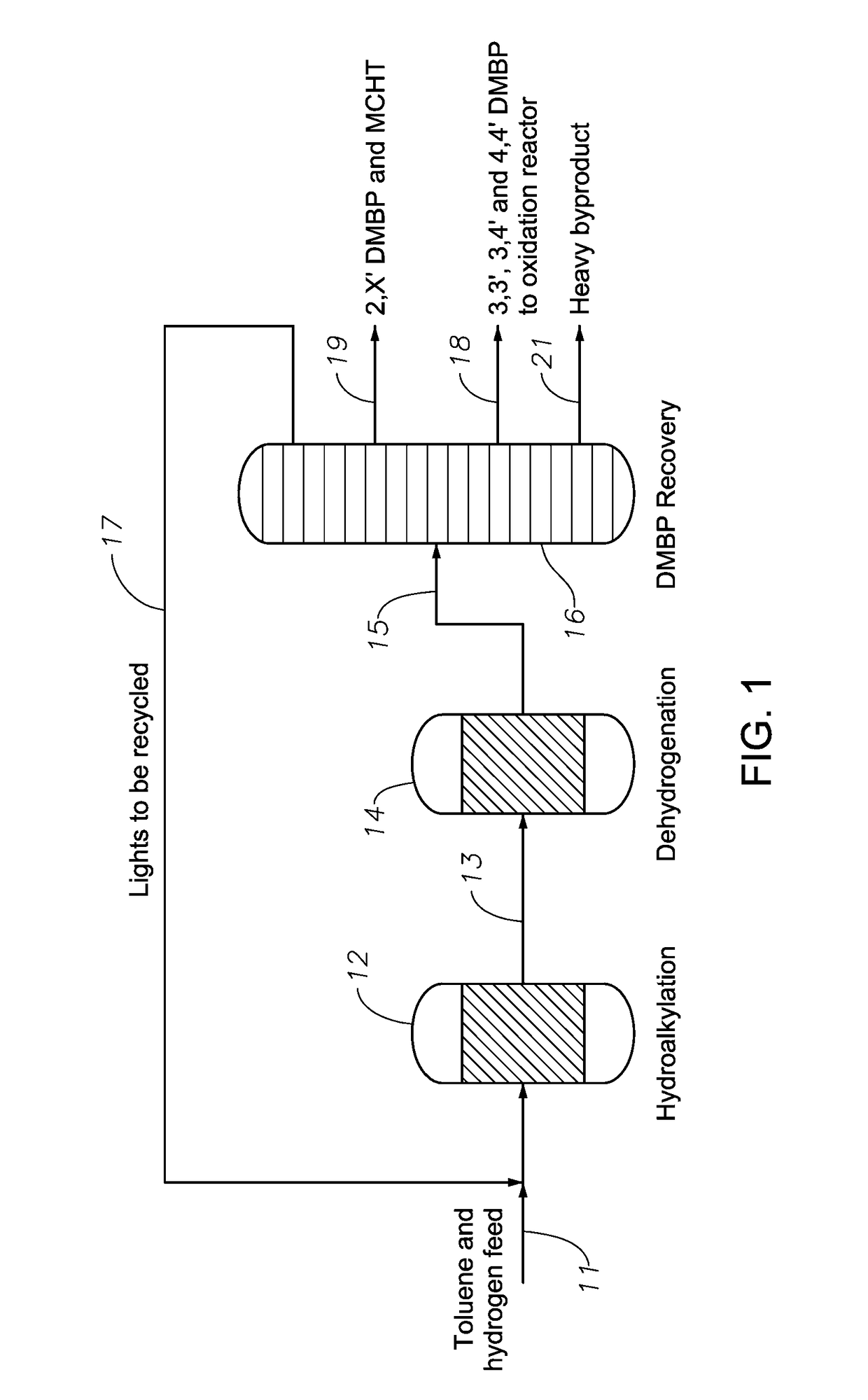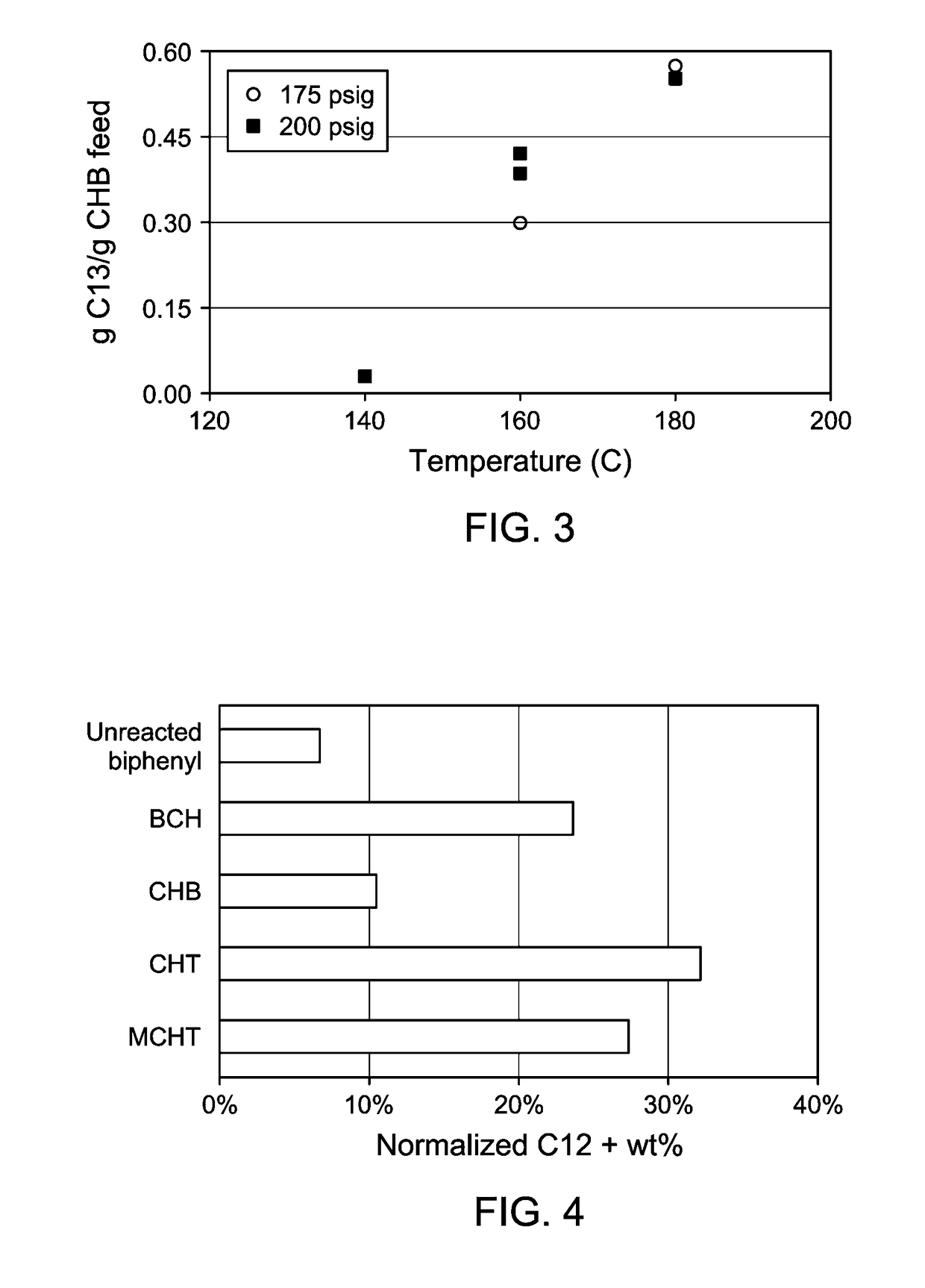Process for preparing dialkylbiphenyl isomer mixtures
a technology of dialkylbiphenyl isomers and dialkylbiphenyl isomers, which is applied in the direction of hydrocarbon preparation catalysts, hydrocarbon by metathesis reaction, hydrocarbon by addition and hydrogenation, etc., can solve the problems of unreacted mcht and unreacted mcht, and the dmbp of 2,2′, 2,3′ and 2,4′ cannot be completely separated from unreacted mcht by distillation
- Summary
- Abstract
- Description
- Claims
- Application Information
AI Technical Summary
Benefits of technology
Problems solved by technology
Method used
Image
Examples
example 1
[0124]The experiments described in Examples 1 and 2 utilized a reactor unit with 8 parallel reactors heated by furnace. For different tests anywhere from 1-8 reactors could be utilized. The reactors used in these experiments consisted of quartz tubes of 9 mm in diameter. Annular N2 flow on the outside of the quartz reactor allowed for pressure equilibration between the inside and outside of each reactor channel. Catalyst extrudates were crushed to 20 / 40 mesh loaded in quantities ranging from 0.25-2 g (to vary corresponding weight based space velocity) after being diluted up to 4 g in crushed quartz. A quartz wool plug was used at the top and bottom of the catalyst bed to keep catalyst in place. Two sets of 4 parallel reactors were placed in heated furnaces to control isothermal reaction temperature. Each reactor contained an internal thermocouple in the catalyst bed in a ⅛″ thermowell. The reactors were topped off with the same quartz chips.
[0125]The catalysts in all reactors were p...
example 2
[0136]The procedure and apparatus of Example 1 were employed but with one reactor channel being utilized to study the sequential hydrogenation and transalkylation of biphenyl in a stacked bed configuration. 1 gram each of a commercial platinum / palladium hydrogenation catalyst and a commercial USY catalyst were loaded in a stacked bed configuration with the hydrogenation catalyst upstream of the zeolite catalyst. The catalysts were dried in N2 overnight at 260° C. and then a reduction procedure followed where 5 sccm H2 was flowed over the bed at 50 psig and the temperature was ramped at 5° C. / min to 290° C. This temperature was held for 3 hours and then the reactor was cooled to the starting reaction temperature of 200° C. A liquid feed consisting of 10% biphenyl and 90% toluene by weight was fed to the reactor at 1 WHSV (total) with a co-feed of hydrogen at a 2:1 hydrogen to hydrocarbon molar ratio.
[0137]In this example, at 200° C. and 200 psig (1480 kPa-absolute), greater than 90% ...
example 3
[0138]In this Example, a study was conducted on the sequential hydrogenation and toluene transalkylation of dimethylbiphenyl in a mixed bed configuration with simultaneous toluene transalkylation. The reaction test was carried out in a fixed bed down-flow reactor having a diameter of 0.5 inch (1.3 cm). The catalysts used in the study were a mixed bed of commercial USY / Al2O3 and Pd / MCM-49 hydroalkylation catalyst (in varying ratio). The catalyst charge was 4 g. The catalyst was activated by heating up the catalyst bed to 260° C. under nitrogen and drying overnight. The catalyst was then reduced in hydrogen at 290° C. (ramp rate of 5° C. / min) for 3 hours. Hydrogen flow rate was 50 sccm. Reactor pressure was maintained constant, at 50 psig (346 kPa-absolute), throughout catalyst activation.
[0139]The liquid feed used in this test was a mixture of 90% anhydrous toluene and 10% 2,3′ DMBP. Hydrogen to hydrocarbon ratio of 2:1 (molar) was used. The total WHSV used in this experiment was 1, ...
PUM
| Property | Measurement | Unit |
|---|---|---|
| temperature | aaaaa | aaaaa |
| wt % | aaaaa | aaaaa |
| wt % | aaaaa | aaaaa |
Abstract
Description
Claims
Application Information
 Login to View More
Login to View More - R&D
- Intellectual Property
- Life Sciences
- Materials
- Tech Scout
- Unparalleled Data Quality
- Higher Quality Content
- 60% Fewer Hallucinations
Browse by: Latest US Patents, China's latest patents, Technical Efficacy Thesaurus, Application Domain, Technology Topic, Popular Technical Reports.
© 2025 PatSnap. All rights reserved.Legal|Privacy policy|Modern Slavery Act Transparency Statement|Sitemap|About US| Contact US: help@patsnap.com



